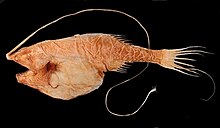Deep-sea fish

Deep sea fish is a term for fish that live below the photic zone of the ocean. The lanternfish is, by far, the most common deep sea fish. Other deep sea fish include the flashlight fish, cookiecutter shark, bristlemouths, anglerfish, and viperfish.
Environment
Because the photic zone typically extends only a few hundred meters below the water, about 90% of the ocean volume is invisible to humans. The deep sea is also an extremely hostile environment, with pressures between 20 and 1,000 atmospheres (between 2 and 100 megapascals), temperatures between 3 and 10 degrees Celsius, and a lack of oxygen. Most fish that have evolved in this harsh environment are not capable of surviving in laboratory conditions, and attempts to keep them in captivity have led to their deaths. For this reason little is known about them, as there are limitations to the amount of fruitful research that can be carried out on a dead specimen and deep sea exploratory equipment is very expensive. As such, many species are known only to scientists and have therefore retained their scientific name.
Characteristics

The fish of the deep sea are among the strangest and most elusive creatures on Earth. In this deep unknown lie many unusual creatures we still have yet to study. Since many of these fish live in regions where there is no natural illumination, they cannot rely solely on their eyesight for locating prey and mates and avoiding predators; deep sea fish have evolved appropriately to the extreme sub-photic region in which they live. Many deep sea fish are bioluminescent, with extremely large eyes adapted to the dark. Some have long feelers to help them locate prey or attract mates in the pitch black of the deep ocean. The deep sea angler fish in particular has a long fishing-rod-like adaptation protruding from its face, on the end of which is a bioluminescent piece of skin that wriggles like a worm to lure its prey. The lifecycle of deep sea fish can be exclusively deep water although some species are born in shallower water and sink on becoming adults.
Due to the poor level of photosynthetic light reaching deep sea environments, most fish need to rely on organic matter sinking from higher levels, or, in rare cases, hydrothermal vents for nutrients. This makes the deep sea much poorer in productivity than shallower regions. Consequently many species of deep sea fish are noticeably smaller and have larger mouths and guts than those living at shallower depths. It has also been found that the deeper a fish lives, the more jelly-like its flesh and the more minimal its bone structure. This makes them slower and less agile than surface fish.
Lanternfish

Sampling via deep trawling indicates that lanternfish account for as much as 65% of all deep sea fish biomass.[1] Indeed, lanternfish are among the most widely distributed, populous, and diverse of all vertebrates, playing an important ecological role as prey for larger organisms. With an estimated global biomass of 550 - 660 million metric tonnes, several times the entire world fisheries catch, lanternfish also account for much of the biomass responsible for the deep scattering layer of the world's oceans. In the Southern Ocean, Myctophids provide an alternative food resource to krill for predators such as squid and the King Penguin. Although plentiful and prolific, currently only a few commercial lanternfish fisheries exist: These include limited operations off South Africa, in the sub-Antarctic, and in the Gulf of Oman.
Endangered species
A 2006 study by Canadian scientists has found five species of deep sea fish – roundnose grenadier, onion-eye grenadier, blue hake, spiny eel and spinytail skate – to be on the verge of extinction due to the shift of commercial fishing from continental shelves to the slopes of the continental shelves, down to depths of 1600 meters. The slow reproduction of these fish – they reach sexual maturity at about the same age as human beings – is one of the main reasons that they cannot recover from the excessive fishing.[2]
See also
References
- ^ Hulley, P. Alexander (1998). Paxton, J.R. & Eschmeyer, W.N. (ed.). Encyclopedia of Fishes. San Diego: Academic Press. pp. 127–128. ISBN 0-12-547665-5.
{{cite book}}: CS1 maint: multiple names: editors list (link) - ^ Jennifer A. Devine, Krista D. Baker and Richard L. Haedrich; "Fisheries: Deep-sea fishes qualify as endangered" in Nature, vol 439, p. 29



